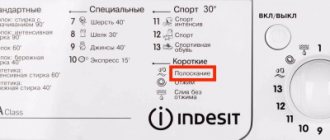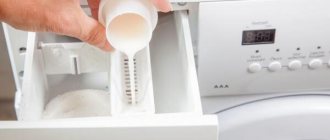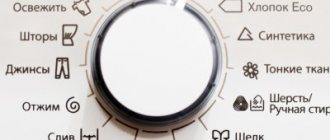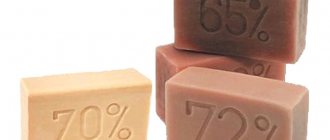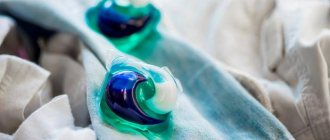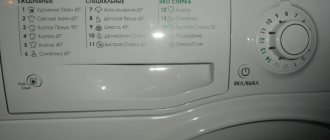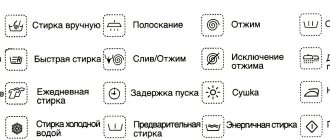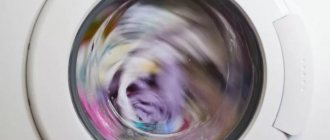The number of programs in modern washing machines is large. Therefore, many users think about which one is better for processing this or that thing.
The basic mode on all washing machine models is the “Synthetic” mode, but not everyone knows exactly what kind of things it is intended for.
Read the article about how to properly wash things using this program, why it is needed, what fabrics it is suitable for and more.
What is this program?
“Synthetic” is a program that is designed for washing items made from mixed fabrics and artificial fibers. Manufacturers of modern washing machines always include it in the list of main modes.
It involves gentle processing of items at low temperatures and medium spin speeds.
The program corresponds to an icon of an empty flask or hanger . Most manufacturers prescribe it verbally, so there will be no difficulties in finding the program, and all symbols are deciphered in the User's Manual.
What problems does it solve?
In the “Synthetic” mode, you can wash items of different colors at the same time. The main thing is that they are durable.
Problems that can be solved using this program:
- Refresh the products (recommended washing temperature is 30 degrees).
- Get rid of minor dirt and foreign odors (recommended washing temperature is 40 degrees).
- Cope with difficult stains and persistent odors (recommended washing temperature is 60 degrees).
If the stains are old or highly pigmented, you must additionally use the “Pre-wash” function.
This mode is used to wash items made from fabrics such as:
- Lurex;
- microfiber;
- velsoft;
- nylon;
- elastane;
- lycra;
- polyester and others.
These fabrics are used to sew:
- jackets,
- t-shirts,
- underwear,
- bed sheets,
- dresses,
- sweaters and more.
Pure synthetic items are rare. In most cases, the composition contains several tissues at once. If synthetic fiber predominates, then the choice when washing should be given to this particular mode.
Information about which program to wash a particular product should be found on the label, which is sewn into one of the internal seams.
How to wash synthetics by hand
Procedure:
- Fill a bowl with warm water and add detergent - preferably gel;
- Soak the item for half an hour;
- Gently remember the products with your hands, then rinse several times.
Attention! You cannot rub synthetic items with force, otherwise the fibers will be deformed, which will ruin the appearance of the product.
After washing, you must wait until the water has drained (do not twist the item) and hang the clothes on hangers to dry.
By the way, if a synthetic item is too large, then its size can be reduced. To do this, carefully wash the product in warm water, let it drain and place it inside out on a hot radiator or directly under the sun's rays. A similar method can be used for polyester and nylon. Things made of acrylic, lycra and spandex do not shrink.
Basic washing steps
When choosing the “Synthetic” mode, washing goes through the following stages:
After pressing the “Start” button, water flows into the drum.- The heating element is turned on, heating it to 40-60 degrees (depending on the settings).
- Water enters the cuvette, which washes the powder out of section No. 2.
- Detergent enters the drum.
- The wash starts.
- Things are rinsed in clean water, after which it is drained and the spin cycle starts.
- The drum rotates at a maximum speed of 800 revolutions provided by the mode. If necessary, the spin can be turned off or reduced to 400 rpm.
This will complete the washing. Options that can be activated in Synthetic mode:
- prewash;
- soak;
- drying;
- additional rinse.
Preparing for washing
To wash synthetics use:
- washing powder designed specifically for synthetics, wool or silk;
- soap (laundry soap or other soap that is on hand, but colorless).
When hand washing synthetics, use as much water as possible. After washing the laundry in several waters, it is necessary to rinse the item - do not wring out the item.
Also consider the type of fabric:
- Acrylic.
Such products are washed by hand in regular warm water or in a machine, setting the “Delicate” mode. It is not advisable to iron the fabric - ironing is only permissible through gauze soaked in water.
- Acetate.
Unresistant to wear, highly electrified, yet light and soft. As in the previous case, the “Delicate” mode and hand wash are suitable. Additionally, an antistatic agent should be added to the compartment. Ironing - through wet gauze and from the inside out.
- Polyester
. Water temperature – up to 40 °C; add an antistatic agent when rinsing the product. Ironing – iron in “Silk” mode up to 150 °C with moistened gauze.
- Polyamide, polyurethane, elastane
. Water temperature – up to 30 °C with the addition of products for silk or wool. Drying in direct sunlight is prohibited. Ironing modes – “Napron” or “Synthetics”.
Do not exceed the maximum temperature of the water or the heating of the iron - otherwise the item will acquire a yellowish tint and the fibers will begin to melt.
Regardless of the type of fabric, always read the label information. The manufacturer informs you at what temperature and how to wash a particular item, and whether it can be ironed.
Before washing, you need to soak the item for half an hour in a container with detergent dissolved in warm water. If it is heavily soiled, wet the item and apply a small amount of chlorine-free stain remover to the stain. Next, rinse the fabric and wash the item - in a machine or by hand.
At what temperature does the machine wash?
When selecting the “Synthetic” mode, the water temperature will differ depending on the model of the washing machine. However, there is one rule - it should not exceed 60 degrees . Otherwise, things will be damaged after washing. The main consequence is the shrinkage of the product by 1-2 sizes.
In most SMA models, the default temperature is 40 degrees. It can be increased to 60 degrees manually by pressing the corresponding key. There are also devices that provide two programs at once. They differ in the degree of water heating and the duration of washing.
Temperature
Each washing method has clear parameters that were obtained through long research and optimization of fabric cleaning processes.
All over the world, uniform standards have been adopted for all types of fabrics:
- 90-95 degrees is great for cotton and linen items. It is recommended to wash heavily soiled bed linen and towels.
- 60 degrees is the best option for synthetic products.
- 40 degrees – washing woolen items.
- Less than 40 degrees. Nowadays, most brands have begun to introduce a quick wash function (15 to 30 minutes), which uses water from 20 to 30 degrees. Most often, lightly soiled products are refreshed using this mode.
Do not wash colored items at high temperatures, as this may cause the paint to wash out.
If for some reason the temperature set by the manufacturer does not suit the user and he wants to change it, then it is very important to know what temperature is permissible for a particular product.
The label contains this information. It is not recommended to make it larger, as the product may fade, shrink or stretch.
Features of use
When processing things in the “Synthetic” mode, the following features must be taken into account:
It is better to wash products with a predominance of artificial fibers not with powder, but with gel.
It is easily washed out of the fabric and dissolves faster, which eliminates the need for pre-soaking and additional rinsing.- The detergent is added to the section of the tray indicated by number II. Water enters it during the main wash stage.
- If the “Pre-wash” function has been activated, then the powder is also poured into section I. Gels cannot be poured there, as they will flow out of the tray ahead of time.
- If you use loose washing powder for washing, it is recommended to use the “Extra rinse” function.
Manual cleaning of synthetic products
Washing polyester by hand will take longer than washing it automatically, but this method guarantees the most gentle cleaning of the fabric.
Warm water at a temperature of 30-40 degrees is filled into a basin. You can use powder, but small granules are not always completely washed out from the structure of the matter, since they take a long time to dissolve in liquid. Therefore, it is recommended to purchase liquid products. Washing gels and shampoos do not leave stains on the fabric.
For heavily soiled clothes, first soak them in soapy water for 20-30 minutes. Contaminated areas can be cleaned with a soft brush. Although polyester fibers are not susceptible to mechanical damage, you should still not rub the fabric too hard with a brush. Then the product is rinsed with warm water, gently squeezed and the moisture is allowed to drain. Jackets, coats and raincoats are not wrung out; they are dried on hangers.
detailed instructions
The instructions for activating the “Synthetic” mode are the same for most SMA models. It involves performing the following actions:
- Sort items by color and degree of soiling, remove all small items from pockets, turn items inside out and load them into the drum.
- Add powder or gel to the tray.
- Select the “Synthetic” washing program.
- Adjust the water temperature if necessary. It should not exceed 60 degrees.
- Set the spin speed (maximum 800 rpm).
- Enable the Start button.
- Wait until the washing is completed, take out the items and send them to dry.
If the laundry is heavily soiled, select the additional option “Pre-wash”.
Nuances for different types of washing machines
Depending on the manufacturer of the washing machine, the synthetic mode will have some features.
For SMA Bosch:
- water temperature 30-40 degrees;
- washing time 70-140 minutes;
- any spin speed that is set by the user;
- The rinsing time is standard; if necessary, you can use the additional rinse function.
To achieve maximum washing quality, the drum should be filled ½ full.
Features of the mode on Siemens SMA:
Water temperature can vary between 30-60 degrees. The user sets the required parameters.- Rinse is set by default. You cannot disable this feature. If necessary, you can use the additional rinse option.
- Average wash time: 1 hour 35 minutes. It may increase or decrease depending on the adjustment of the water temperature and other parameters.
- The rotation speed of the drum can be changed. If necessary, the spin is turned off.
The optimal result can be obtained if you load no more than 2.5 kg of laundry into the drum.
Features of the program on SMA Samsung:
- water temperature 40-60 degrees;
- The default drum rotation speed is 800 rpm, but if necessary it can be reduced;
- water consumption does not exceed 62 liters per cycle;
- The program starts without pre-soaking.
To improve the quality of washing, do not overload the drum. The optimal weight is 2.5 kg. Moreover, you need to calculate based on the mass of wet laundry.
Features of the mode for SMA Indesit:
- The first type of program is called “Synthetics 1”. The water temperature is 60 degrees, and the washing duration is 75 minutes.
- The second type of program is called “Synthetics 2”. In this case, the default water heating is 40 degrees. Washing duration is 71 minutes.
The spin speed in the first and second modes is 800 rpm. If necessary, it can be reduced.
Features of the program for SMA:
- The water temperature is 40 degrees.
- The duration of the wash depends on the settings, by default it lasts 70 minutes.
In some models, this mode is called “Everyday Wash”.
Synthetic mode in Indesit washing machines
The manufacturer Indesit also made sure that almost every machine has the Synthetics program. Modern units even have two types of programs. They have minor differences, but it is important to become familiar with them.
Peculiarities:
- Synthetics 1. Water will heat up to a temperature of 60 degrees Celsius. Prewash cannot be activated. In this case, you will be able to activate the additional option “Whitening”. The wash will take 75 minutes. Spinning is performed at 800 rpm.
- Synthetics 2. According to the standard, the water will heat up to 40 degrees. Due to this, the cycle time is reduced to 71 minutes. Otherwise the settings are identical.
Before choosing a particular program, you will need to carefully study its features. In this case, you will be able to wash synthetic items as efficiently as possible.
Advantages and disadvantages
Advantages:
Careful treatment of fabrics.- Possibility of quick start, without adjusting the temperature and spin speed.
- Possibility of washing items made from mixed fabrics.
- The mode is combined with the options “Extra rinse”, “Soak”, “Pre-wash”.
- It is possible to use powder, gel and capsules.
- Optimization of resource consumption.
Flaws:
- The water temperature cannot be higher than 60 degrees. Therefore, to remove difficult stains, pre-soaking or using stain removers may be necessary.
- The spin speed should not exceed 800 rpm, so it will not be possible to get completely dry items out of the drum.
Properties of polyester items
Polyester is a versatile and practical fabric made from synthetic components. Things made from it do not wrinkle, dry quickly and are stored for a long period. Skirts, trousers, T-shirts, scarves, as well as jackets and coats are made from polyester fibers. To obtain an antistatic effect and high strength, the material is used as a base with the addition of natural and synthetic threads.
Today you can find things made from 100% polyester or in combination with other fibers. Before cleaning items of clothing, you must carefully read the product care instructions, which can be found on the label. You can wash things made of polyester at different temperatures, since when making things, synthetics can be mixed with wool, cotton or viscose. However, each product must be carefully cared for to avoid deformation of the fabric.
The label usually indicates not only the materials used in the production of clothing, but also care instructions and information on which washing mode should be selected for a particular item. The following is contraindicated for polyester products:
- Boil and wash in hot water. Such procedures lead to shrinkage and loss of attractive appearance of clothing, since due to high temperature the structure of the fibers is disrupted, and white fabrics may turn yellow.
- Bleaching. Chemical bleaches containing aggressive substances can also destroy polyester fibers.
- Dry on a radiator or in the sun.
Fabric cleaning takes place under certain parameters. You can wash polyester items by hand or in the washing machine, but sometimes the label will only indicate one cleaning method to use. Clothes and other products are usually washed using a soft gel and at a temperature not exceeding 40 degrees.
Blankets and jackets with filling should be dry cleaned. The same is done in cases with certain items of clothing, the labels of which indicate that other cleaning methods are prohibited.
Wear-resistant and durable material does not shrink after washing and does not lose shape if you follow the washing rules. Windproof properties prevent jackets and other items of outerwear from allowing moisture to pass through. The restoration of moisture-resistant qualities lost over time occurs with the use of special impregnating emulsions.
